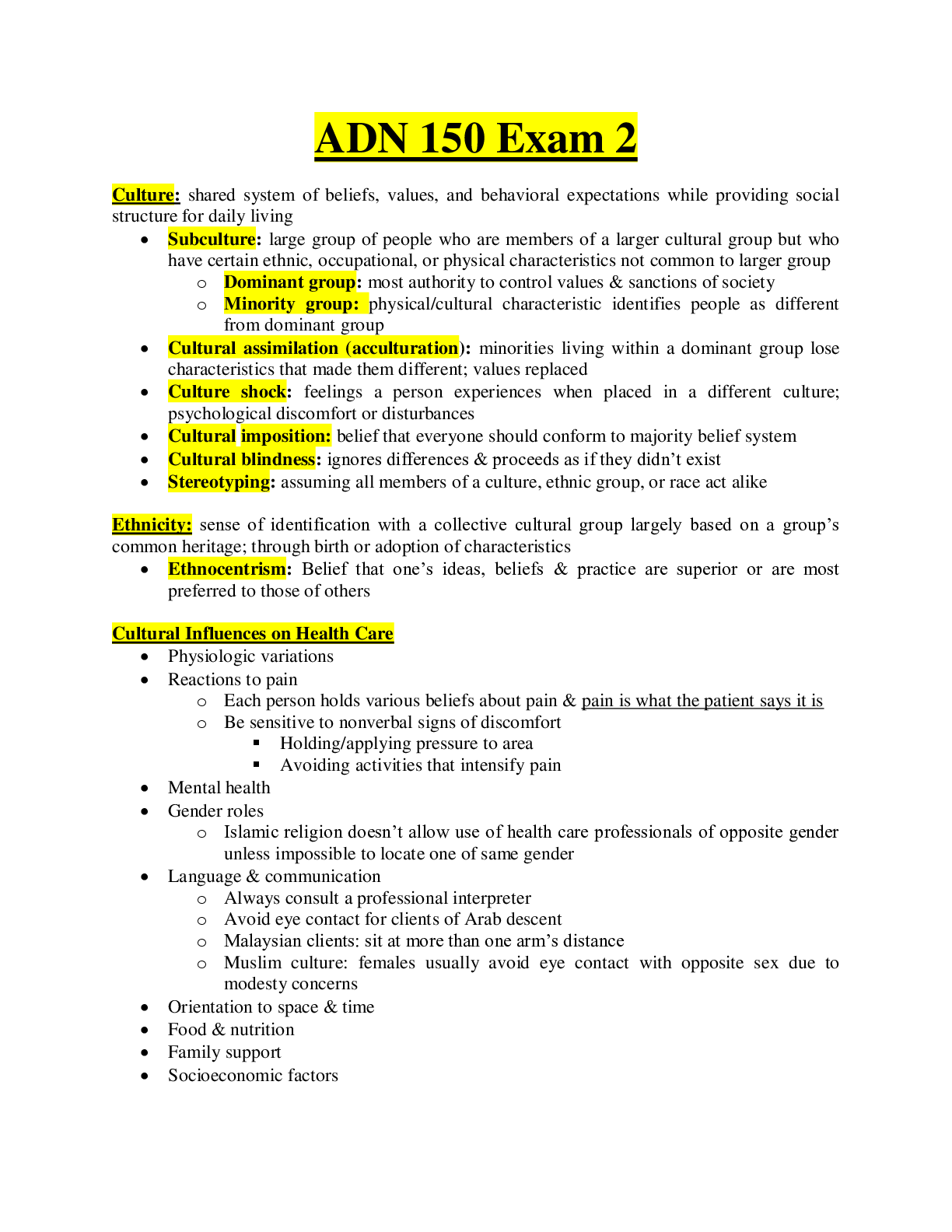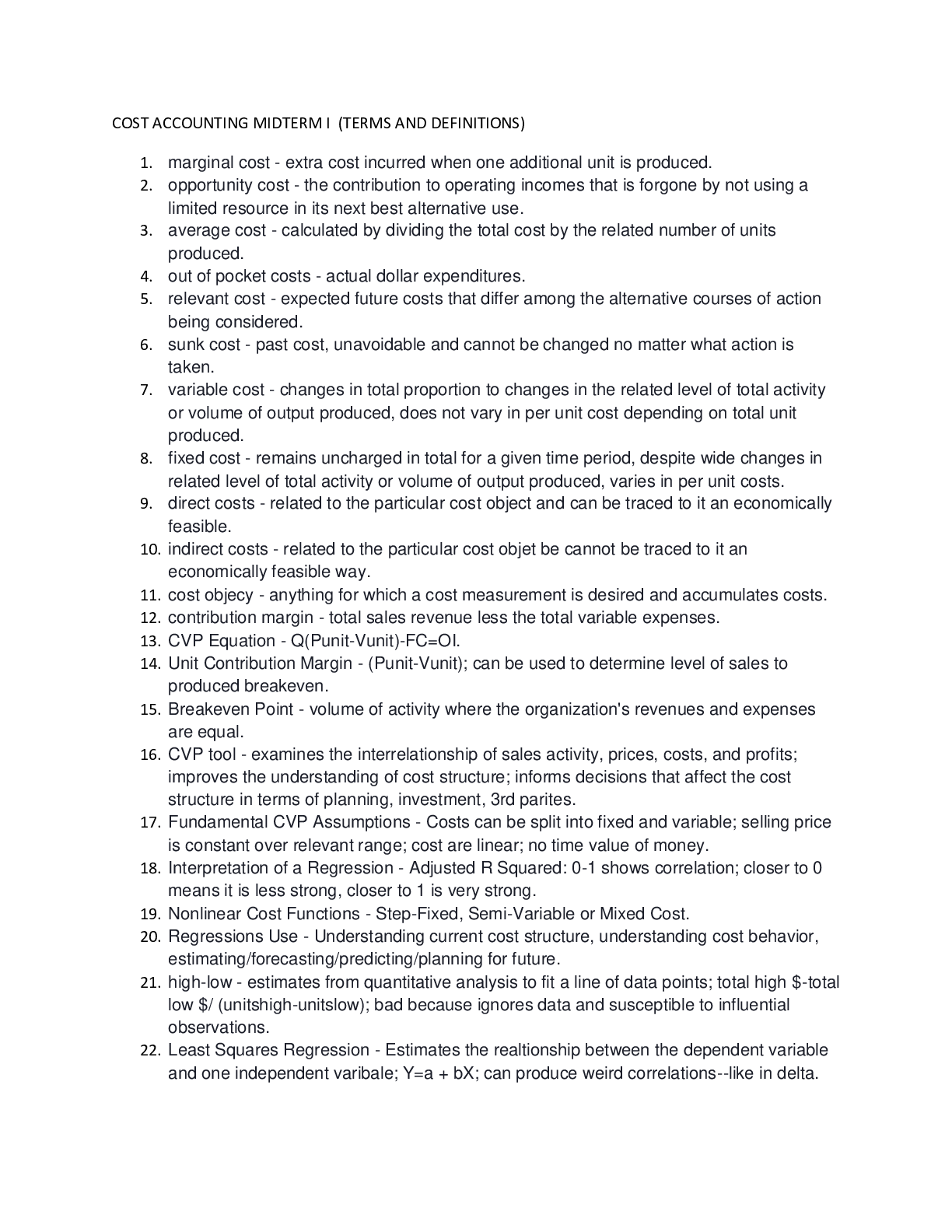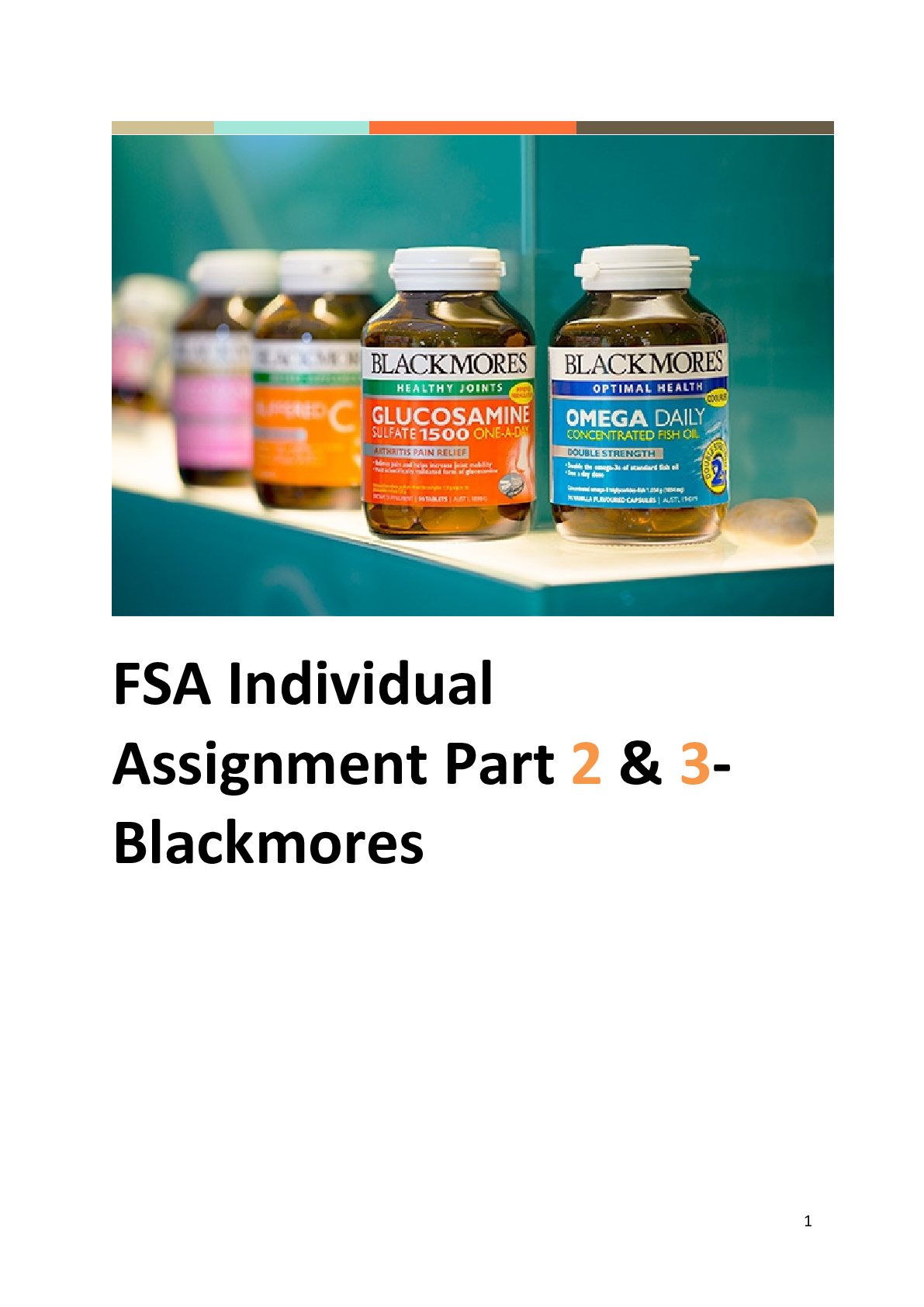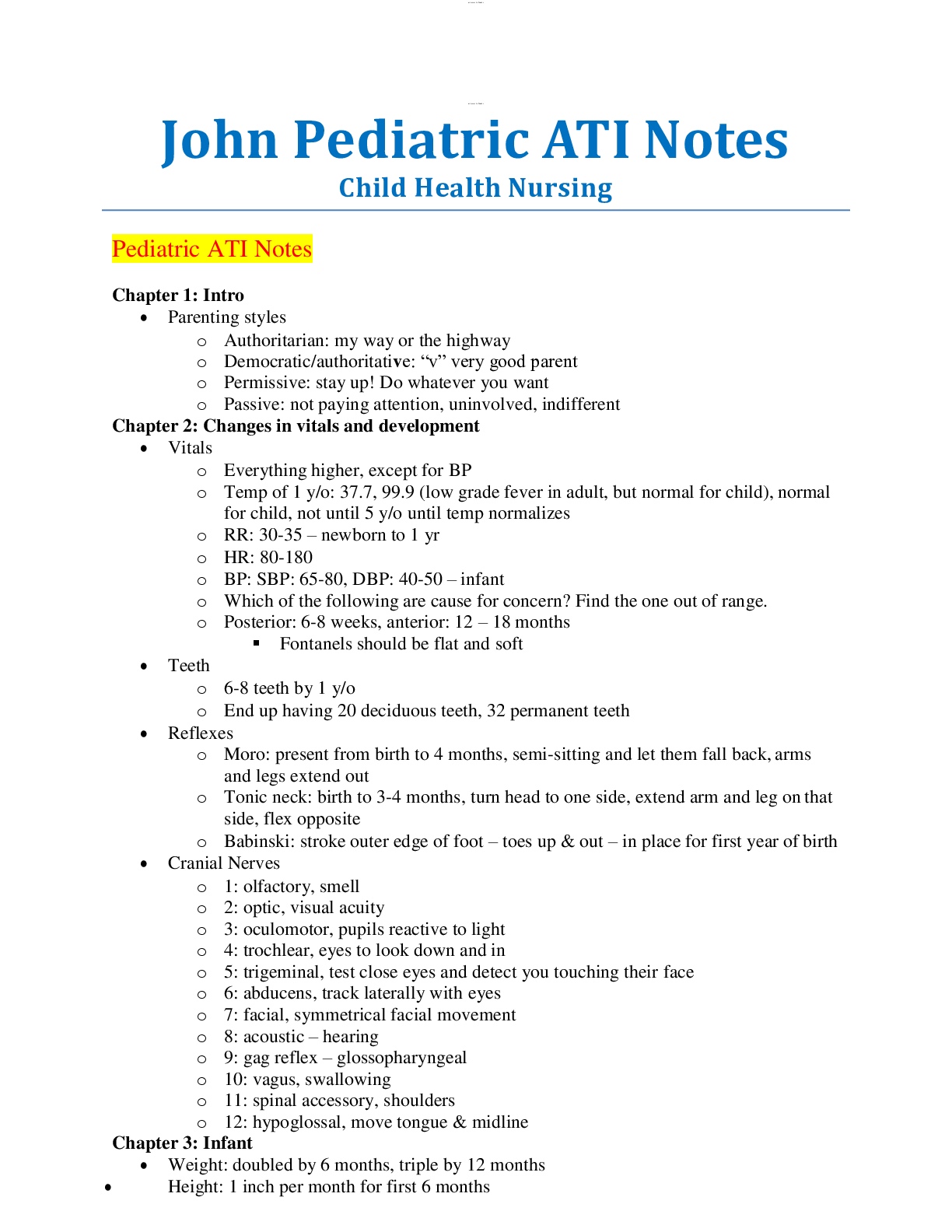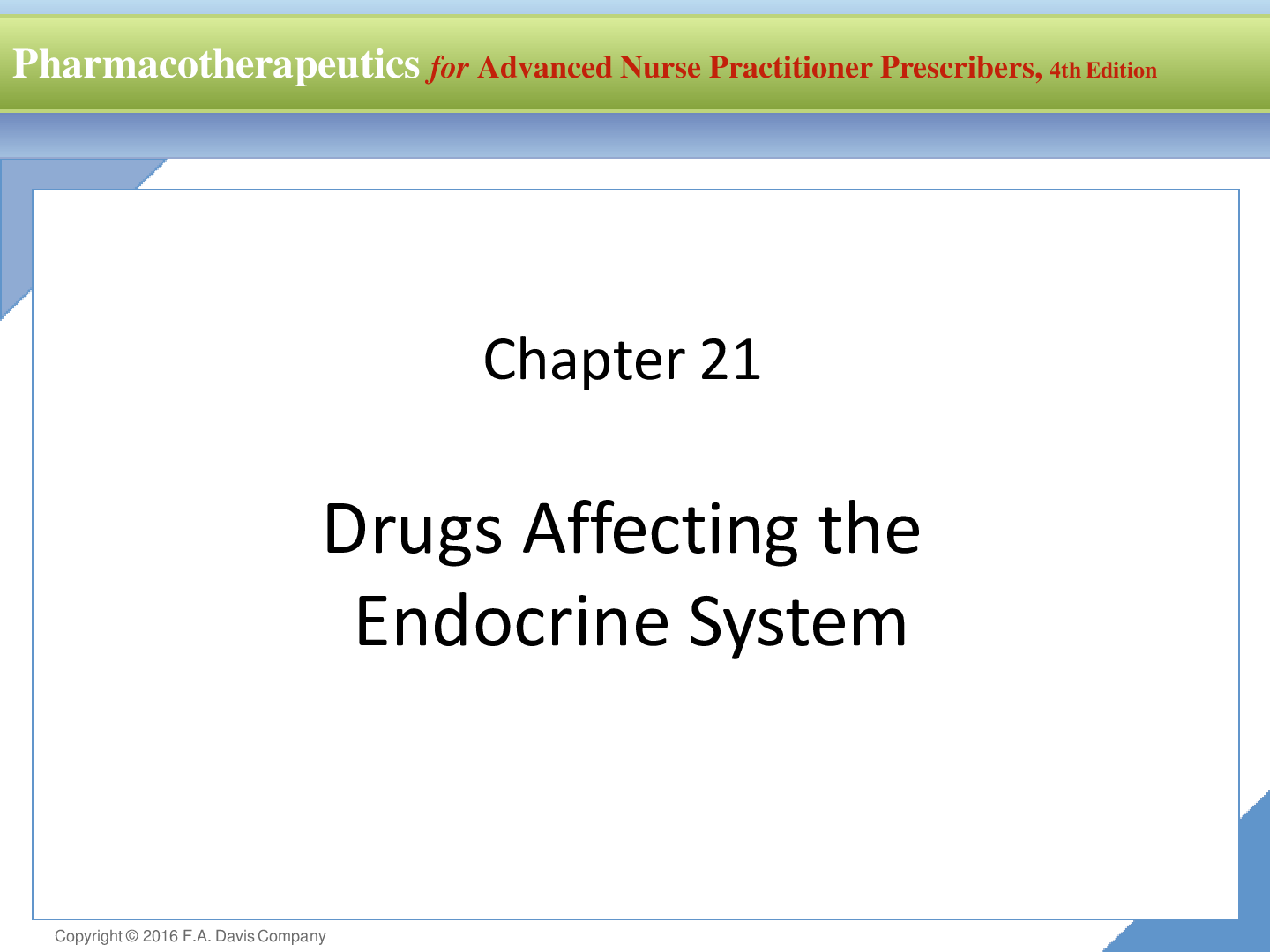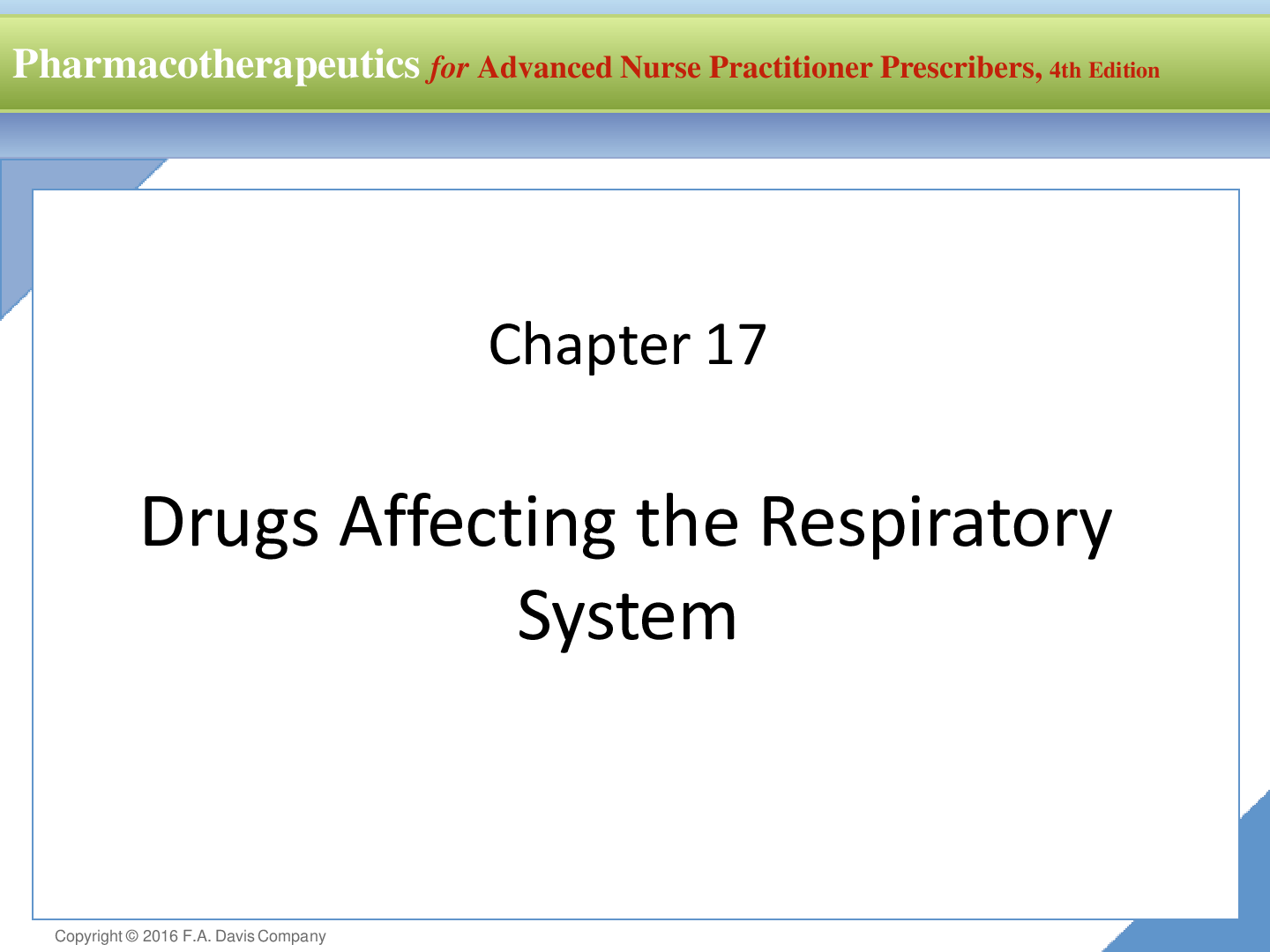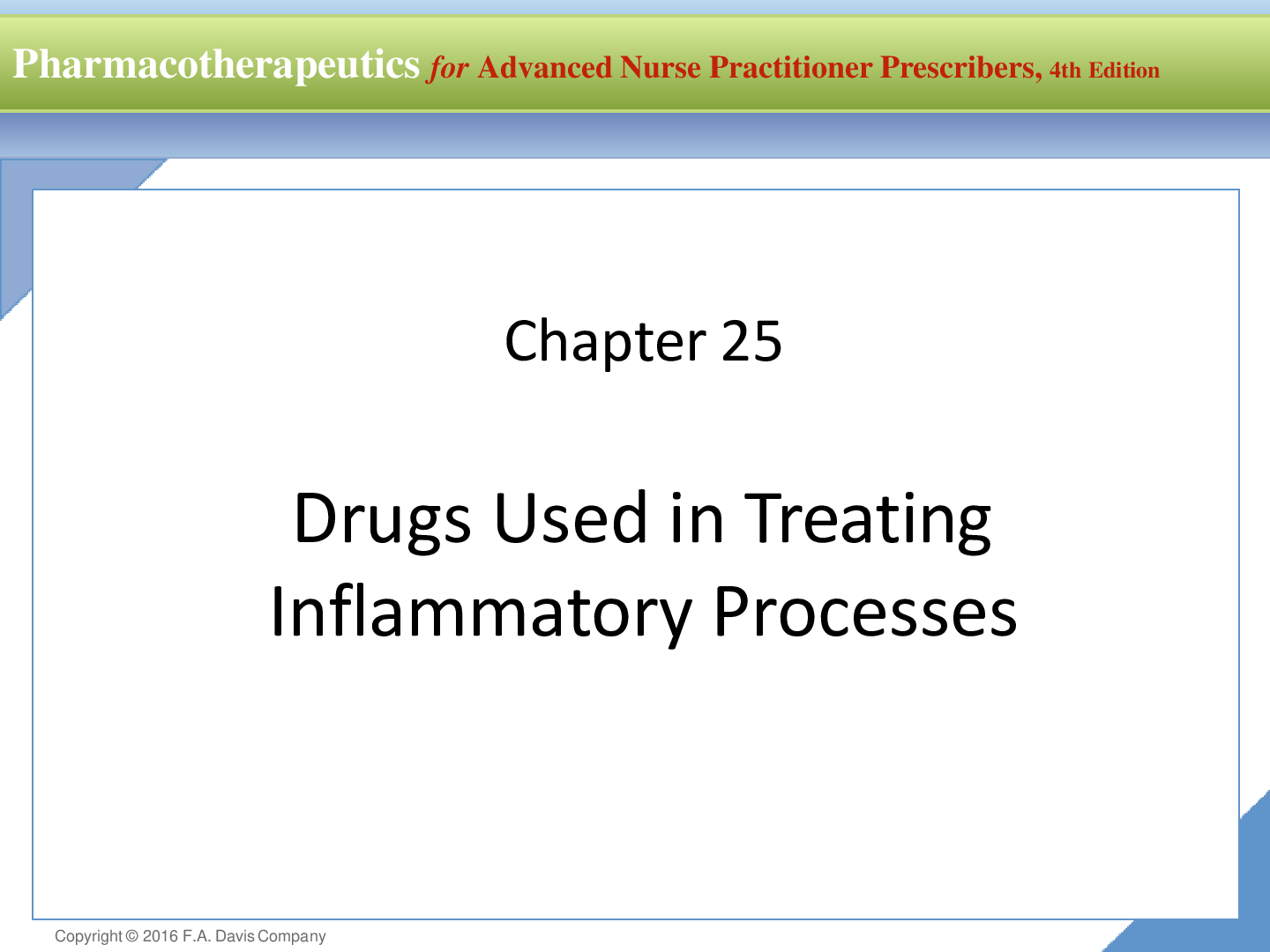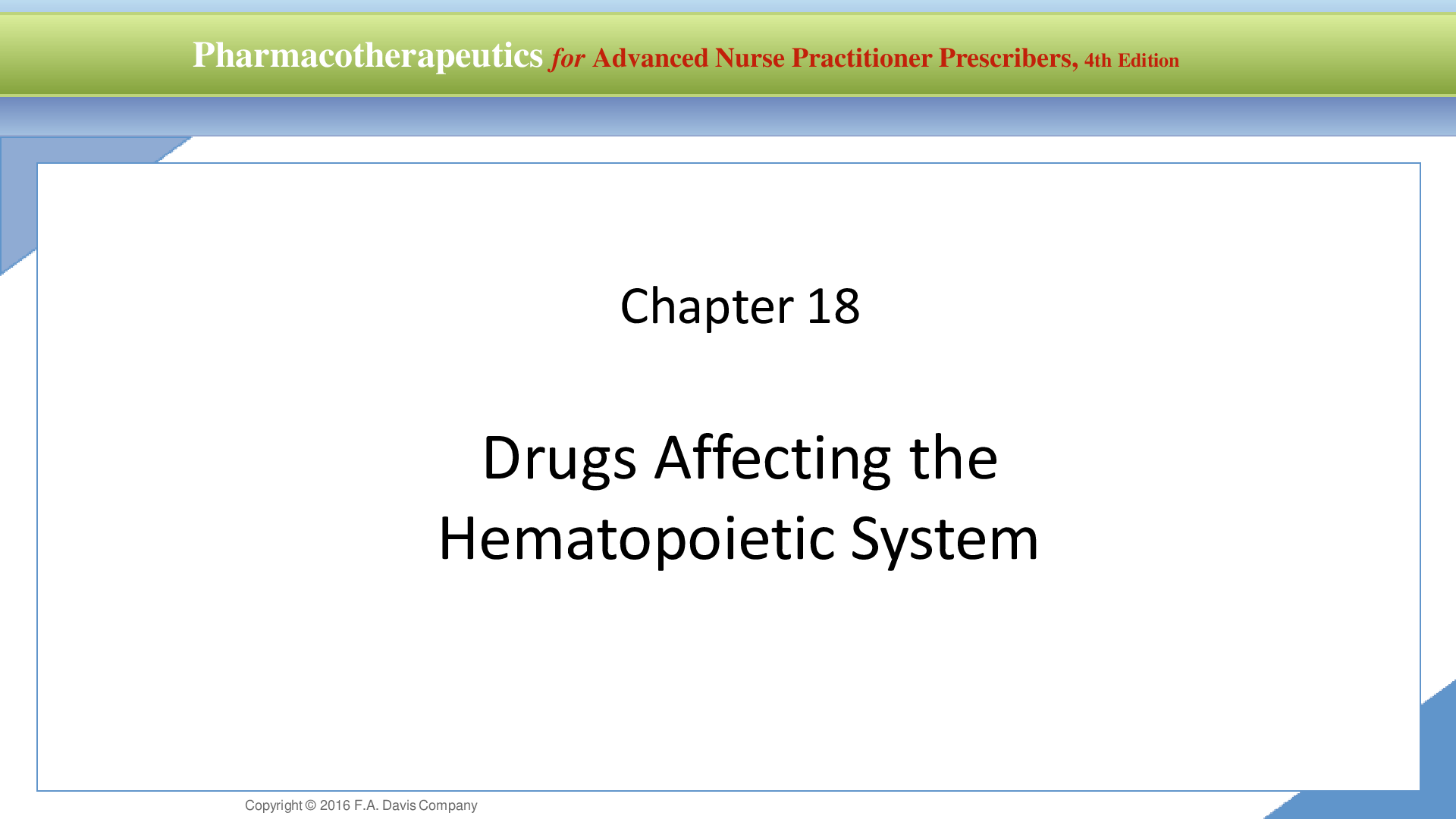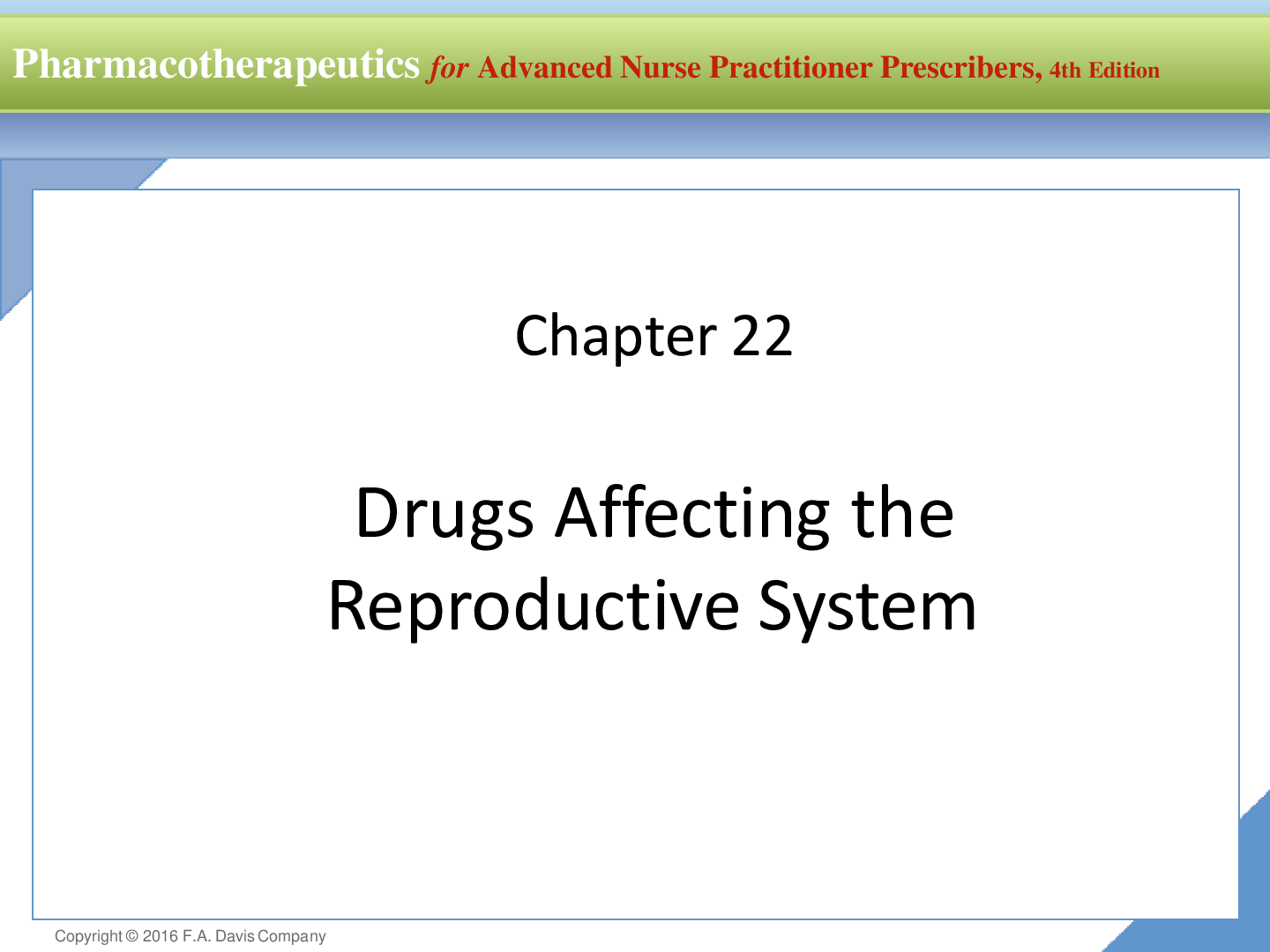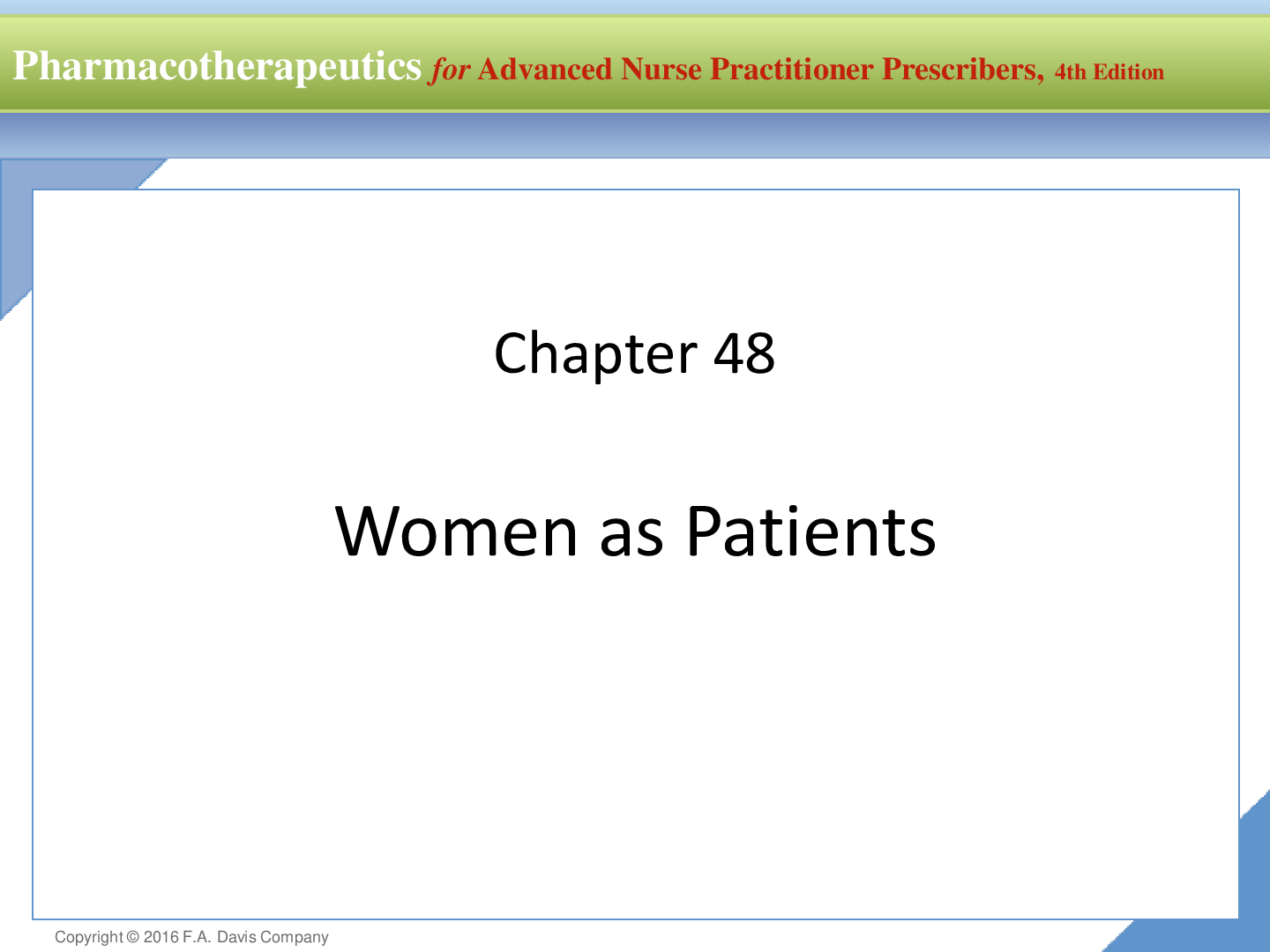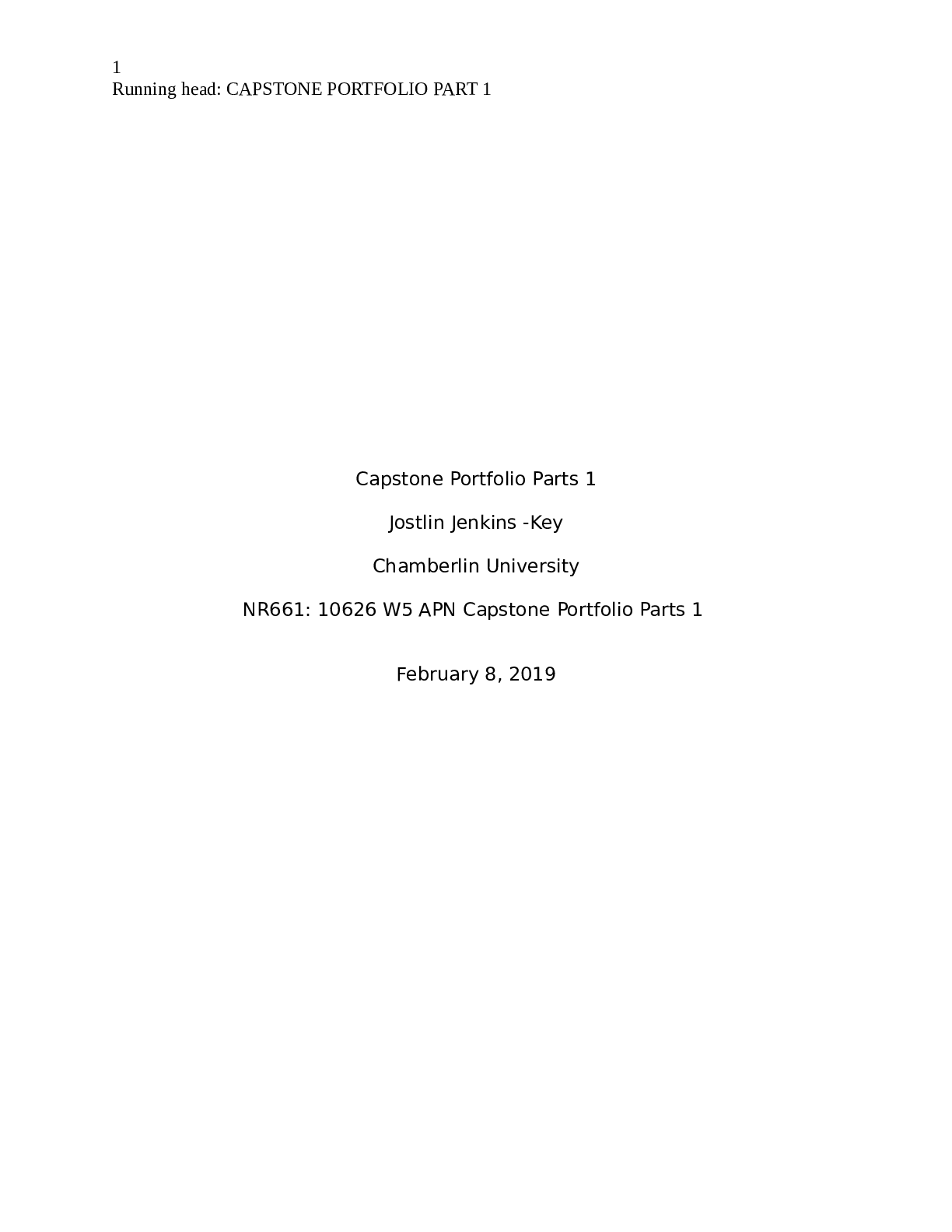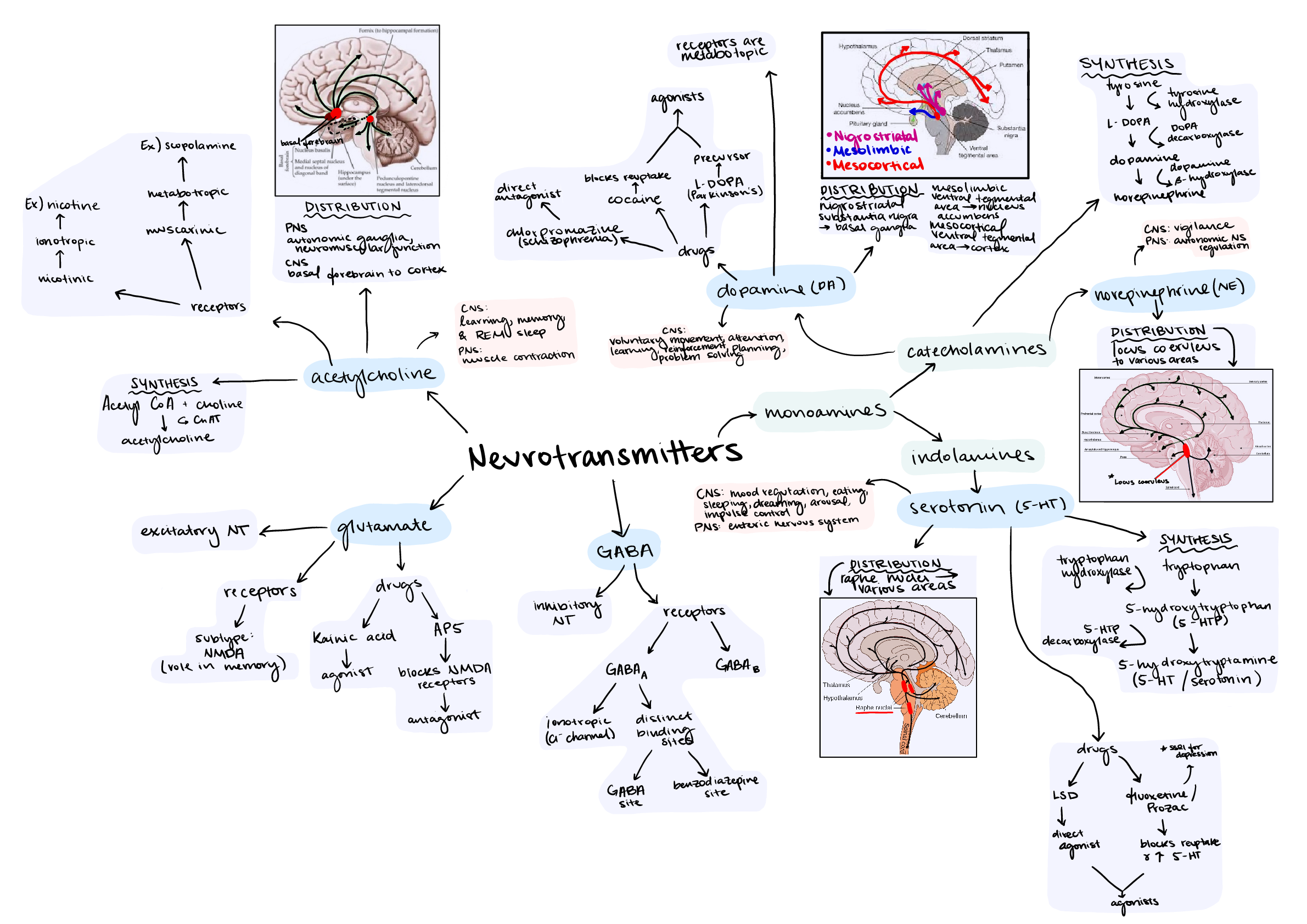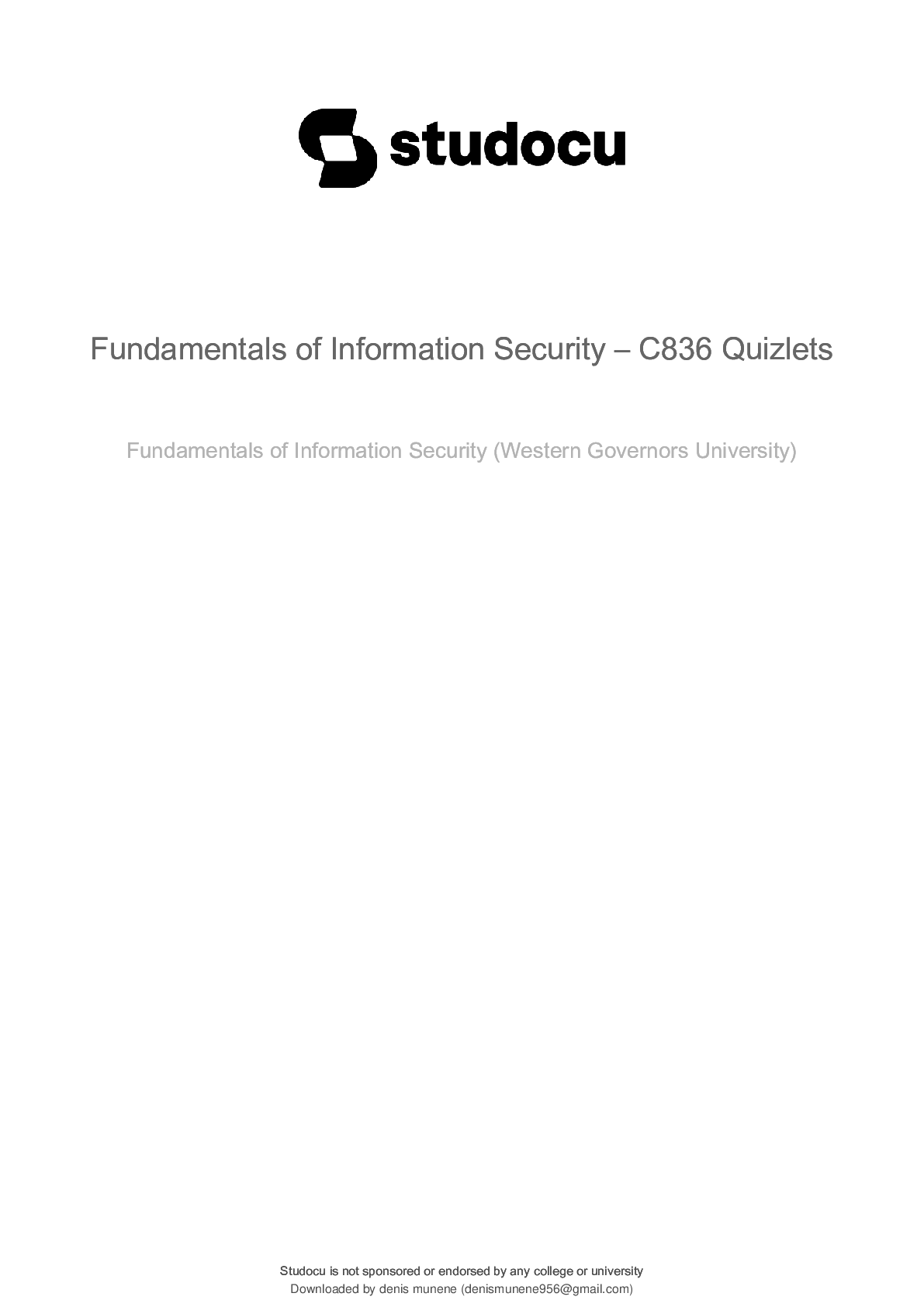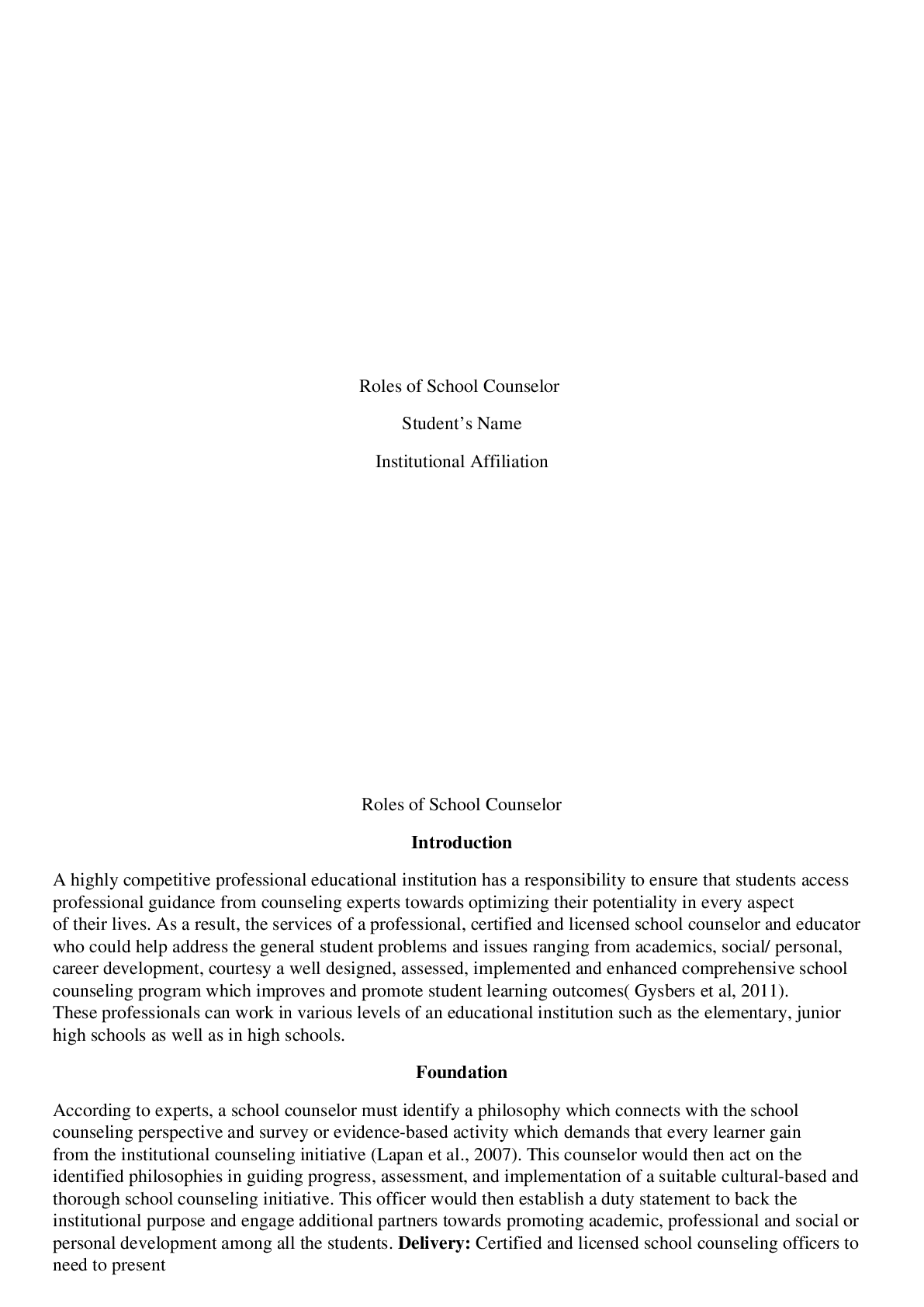Health Care > Class Notes > ADN 150 Final exam guide / ADN 150 Exam 2 complete study guide > Lehigh Carbon Community College (All)
ADN 150 Final exam guide / ADN 150 Exam 2 complete study guide > Lehigh Carbon Community College
Document Content and Description Below
ADN 150 Exam 2 Culture: shared system of beliefs, values, and behavioral expectations while providing social structure for daily living • Subculture: large group of people who are members of a large... r cultural group but who have certain ethnic, occupational, or physical characteristics not common to larger group o Dominant group: most authority to control values & sanctions of society o Minority group: physical/cultural characteristic identifies people as different from dominant group • Cultural assimilation (acculturation): minorities living within a dominant group lose characteristics that made them different; values replaced • Culture shock: feelings a person experiences when placed in a different culture; psychological discomfort or disturbances • Cultural imposition: belief that everyone should conform to majority belief system • Cultural blindness: ignores differences & proceeds as if they didn’t exist • Stereotyping: assuming all members of a culture, ethnic group, or race act alike Ethnicity: sense of identification with a collective cultural group largely based on a group’s common heritage; through birth or adoption of characteristics • Ethnocentrism: Belief that one’s ideas, beliefs & practice are superior or are most preferred to those of others Cultural Influences on Health Care • Physiologic variations • Reactions to pain o Each person holds various beliefs about pain & pain is what the patient says it is o Be sensitive to nonverbal signs of discomfort Holding/applying pressure to area Avoiding activities that intensify pain • Mental health • Gender roles o Islamic religion doesn’t allow use of health care professionals of opposite gender unless impossible to locate one of same gender • Language & communication o Always consult a professional interpreter o Avoid eye contact for clients of Arab descent o Malaysian clients: sit at more than one arm’s distance o Muslim culture: females usually avoid eye contact with opposite sex due to modesty concerns • Orientation to space & time • Food & nutrition • Family support • Socioeconomic factors Transcultural Nursing Care • Dr. Leininger: Theory of Cultural Care Diversity & Universality o Foundation for culturally respectful care for patients of all ages, groups, families, & communities Elements of Cultural Competence • Developing self-awareness • Demonstrating knowledge & understanding of a patient’s culture • Accepting & respecting cultural differences • Not assuming the health care provider’s beliefs & values are the same as client’s • Resisting judgmental attitudes • Being open & comfortable with cultural encounters • Accepting responsibility for one’s own cultural competency Guidelines for Providing Culturally Competent Nursing Care • Develop cultural self-awareness o Beliefs, values, traditions, & practices • Develop cultural knowledge • Accommodate cultural practices o Belief systems of etiology of illness & disease & those related to health & healing • Respect culturally based family roles • Avoid mandating change • Seek cultural assistance Spirituality: anything that pertains to the person’s relationship with a nonmaterial life force/higher power • Faith: a confident belief in something for which there is no proof • Religion: term used to describe cultural/institutional religion • Hope: ingredient in life responsible for a positive outlook Meeting Spiritual Needs • Offering a compassionate presence • Assisting in struggle to find meaning in face of suffering, illness, & death • Fostering relationships that nurture the spirit • Facilitating patient’s expression of religious/spiritual beliefs & practices Anandarajah & Hight’s (HOPE)- Assessing Spiritual Needs • H- Sources of hope, meaning, comfort, strength, peace, love, & connection • O- Organized religion • P- Personal spirituality & practice • E- Effects on medical care & end-of-life issue Patient Goals/Outcome: Spiritual Distress • Identify spiritual beliefs that meet needs for meaning & purpose, love & relatedness & forgiveness • Derive strength, hope, & comfort from these beliefs • Develop spiritual practice that nurture communion with inner self, God & the world • Express satisfaction with compatibility of spiritual beliefs & everyday living • Explore origin of spiritual beliefs & practices • Identify factors in life that challenge spiritual beliefs • Explore alternatives to challenges • Identify spiritual supports • Report/demonstrate decreased spiritual distress after intervention Implementing Spiritual Care • Offer supportive presence • Facilitate patient’s practice of religion • Nurture spirituality • Pray with patient • Pray for patient • Counsel patient spiritually • Contact a spiritual counselor • Resolve conflicts between treatment & spiritual activities Facilitating Practice of Religion • Familiarize patient with religious services within institution • Respect patient’s need for privacy during prayer • Assist patient to obtain devotional objects & protect from loss/damage • Arrange for patient to receive sacraments if desired • Attempt to meet dietary restrictions • Arrange for priest/minister/rabbi to visit Teaching Acronym • T- Tune into patient • E- Edit patient information • A- Act on every teaching moment • C- Clarify often • H- Honor patient as partner in education process Learning Domains • Cognitive: storing & recalling of new knowledge o Lecture, panel, discovery, written materials o Andragogy: art & science of helping adults learn • Psychomotor: learning a physical skill o Demonstration, discovery, printed materials • Affective: changing attitudes, values, & feelings o Role modeling: allows the learner to experience, relive, or anticipate an event o Discussion o Audiovisual materials Interventions While Educating Elderly Adults • Allow extra time • Plan short teaching sessions • Accommodate for sensory deficits • Reduce environmental distractions • Relate new information to familiar activities or information Cope Model: helping family members become effective problem solvers & support your teaching efforts • C- creativity • O- optimism • P- planning • E- expert information Promoting Compliance • Be certain that instructions are understandable & support patient goals • Include patient & family as partners in process • Utilize interactive teaching strategies • Develop interpersonal relationships with patients & their families Providing Culturally Competent Patient Education • Develop an understanding of patient’s culture • Work with multicultural team • Be aware of personal assumptions, biases, & prejudices • Understand core cultural values of patient/group • Develop written material in patient’s preferred language Successful Teaching Strategies • Establish relationships & identify readiness for change • Identify opportunities, issues, & concerns • Establish patient-centered goals • Create structure of coaching interaction • Empower & motivate patient to achieve goals • Assist patient to determine progress toward goals • Make everyone feel comfortable • Can be formal or informal • Use interpersonal skill of warmth, friendliness, openness, & empathy • Short-term: for situational crisis • Long-term: for developmental crisis • Motivational: discuss feelings & incentives with client • Health promotion: general recommendations on improving overall well being Role of Skeletal System in Movement • Supports soft tissues of body • Protects crucial components of body • Furnishes surfaces for attachment of muscles, tendons, & ligaments • Provides storage areas for minerals & fat • Produces blood cells Movement Terms Abduction: Lateral movement of a body part away from midline of body Adduction: Lateral movement of a body part toward midline of body Circumduction: Turning in a circular motion; combines abduction, adduction, extension & flexion Flexion: State of being bent Extension: State of being in a straight line Hyperextension: State of exaggerated extension Dorsiflexion: Backward bending of hand or foot Plantar flexion: Flexion of foot Rotation: Turning on an axis; turning of a body part on axis provided by its joint Internal Rotation: A body part turning on its axis toward midline of body External Rotation: A body part turning on its axis away from midline of body Pronation: Lying on abdomen; forearm turned so palm faces downward Supination: Lying on back; forearm turn so palm faces upward Inversion: Movement of sole of foot inward (occurs at ankle) Eversion: Movement of sole of foot outward (occurs at ankle) Opposition: Rotation of thumb around its long axi s (movement of thumb across palm to touch each fingertip of same hand) Patient Positioning Fowler’s position: seated in a semi-sitting position (45-60°) Protective Supine Position: lying horizontally with the face & torso facing up Protective Side-Lying/Lateral Position: patient lies on one side of body with top leg in front of bottom leg & hip & knee flexed Protective Sims’ Position: patient lies on their left side, left hip & lower extremity straight with right hip & knee bent Protective Prone Position: lies flat with chest down & back up Effect of Nervous System on Muscle Contraction • Neurons conduct impulses from one part of body to another • Afferent nervous system conveys information to CNS from sensory organs • Information is processed by CNS leading to a response • Efferent neurons convey response from CNS to skeletal muscles by way of somatic nervous system Postural Reflexes: automatic movements- maintain body position & equilibrium, essential for body alignment & balance • Postural tonus: sustained contraction of select skeletal muscles that keeps human body in an upright position against force of gravity, depends on functioning of several postural reflexes; o Labyrinthine sense o Proprioceptor/kinesthetic sense o Visual/optic sense o Extensor/stretch reflexes Factors Influencing Mobility • Developmental considerations • Physical health o Muscular, skeletal, or nervous system problems o Problems involving other body systems • Mental health • Lifestyle • Attitude & values • Fatigue & stress • External factors Types of Exercises Isotonic: muscle shortening & active movement Isometric: muscle contraction without shortening Isokinetic: muscle contraction with resistance Benefits of Exercise to Cardiovascular System • Increased efficiency of heart • Decreased heart rate & blood pressure • Increased blood flow to all body parts • Improved venous return • Increased circulating fibrinolysin (substance that breaks up small clots) Benefits of Exercise to Respiratory System • Improved alveolar ventilation • Decreased work of breathing • Improved diaphragmatic excursion Benefits of Exercise to Musculoskeletal System • Increased muscle efficiency (strength) & flexibility • Increased coordination • Reduced bone loss • Increased efficiency of nerve impulse transmission Effects of Immobility on Body • Cardiovascular system • Respiratory System • Musculoskeletal system • Metabolic processes • Gastrointestinal system • Urinary system • Skin • Psychosocial outlook Variables Leading to Back Injury in Health Care Workers • Uncoordinated lifts • Manual lifting & transferring of patients without assistive devices • Lifting when fatigued or after recent back injury recovery • Repetitive movement such as lifting, transferring, & repositioning patients • Standing for long periods of time • Transferring patients • Repetitive tasks • Transferring/repositioning uncooperative/confused patients Proper Body Mechanics • Use of proper body movement in daily activities • Prevention & correction of problems associated with posture • Enhancement of coordination & endurance Equipment & Assistive Devices • Gait belts • Stand-assist & repositioning aids • Lateral-assist devices • Friction-reducing sheets • Mechanical lateral-assist devices • Transfer chairs • Powered stand-assist & repositioning lifts • Powered full-body lifts Muscle Relaxants Baclofen: (Anti-spasmatic) Centrally acting; treatment of muscle spasticity associated with neuromuscular diseases such as multiple sclerosis, muscle rigidity, & spinal cord injuries Dantrolene: Direct-acting; management of upper motor neuron; associated muscle spasticity such as spinal cord injury, myasthenia gravis, cerebral palsy, multiple sclerosis, muscular dystrophy, polio, tetanus, quadriplegia, & amyotrophic lateral sclerosis; prevention or treatment of malignant hyperthermia- a state of intense muscle contraction & resulting hyperpyrexia; used orally as preoperative prophylaxis in susceptible patients who must undergo anesthesia & after acute episodes to prevent recurrence Hygiene Terms Glossitis: inflammation of tongue Periodontitis: inflammation of the gums that also involves degeneration of periosteum & bone Stomatitis: inflammation of oral mucosa Gingivitis: inflammation of gingival (gums) Pediculosis: lice; frequent scratching & marks on scalp Alopecia: absence/loss of hair Caries: cavities Cerumen: earwax Cheilosis: corners of mouth become inflamed; leads to cracking Halitosis: bad breath Plaque: soft, sticky film built up on teeth Tartar: hard calcified deposit that forms on teeth Purpose of Back Massage • Acts as a general body conditioner • Relieves muscle tension & promotes relaxation • Provides opportunity for nurse to observe skin for signs of breakdown • Improves circulation • May decrease pain, distress, & anxiety • May improve sleep quality • Provides a means of communication through use of touch Purpose of Bathing • Cleanses skin • Acts as a skin conditioner • Helps to relax client • Promotes circulation • Serves as musculoskeletal exercise • Stimulates rate & depth of respirations • Promotes comfort through muscle relaxation & skin stimulation • Provides person with sensory input • Helps improve self-image • Strengthens nurse-patient relationship Providing Bed Baths • Provide articles for bathing on overbed table/bedside stand • Provide privacy for patient • Remove top linens & replace with bath blanket • Place cosmetics in convenient place • [Show More]
Last updated: 1 year ago
Preview 1 out of 36 pages
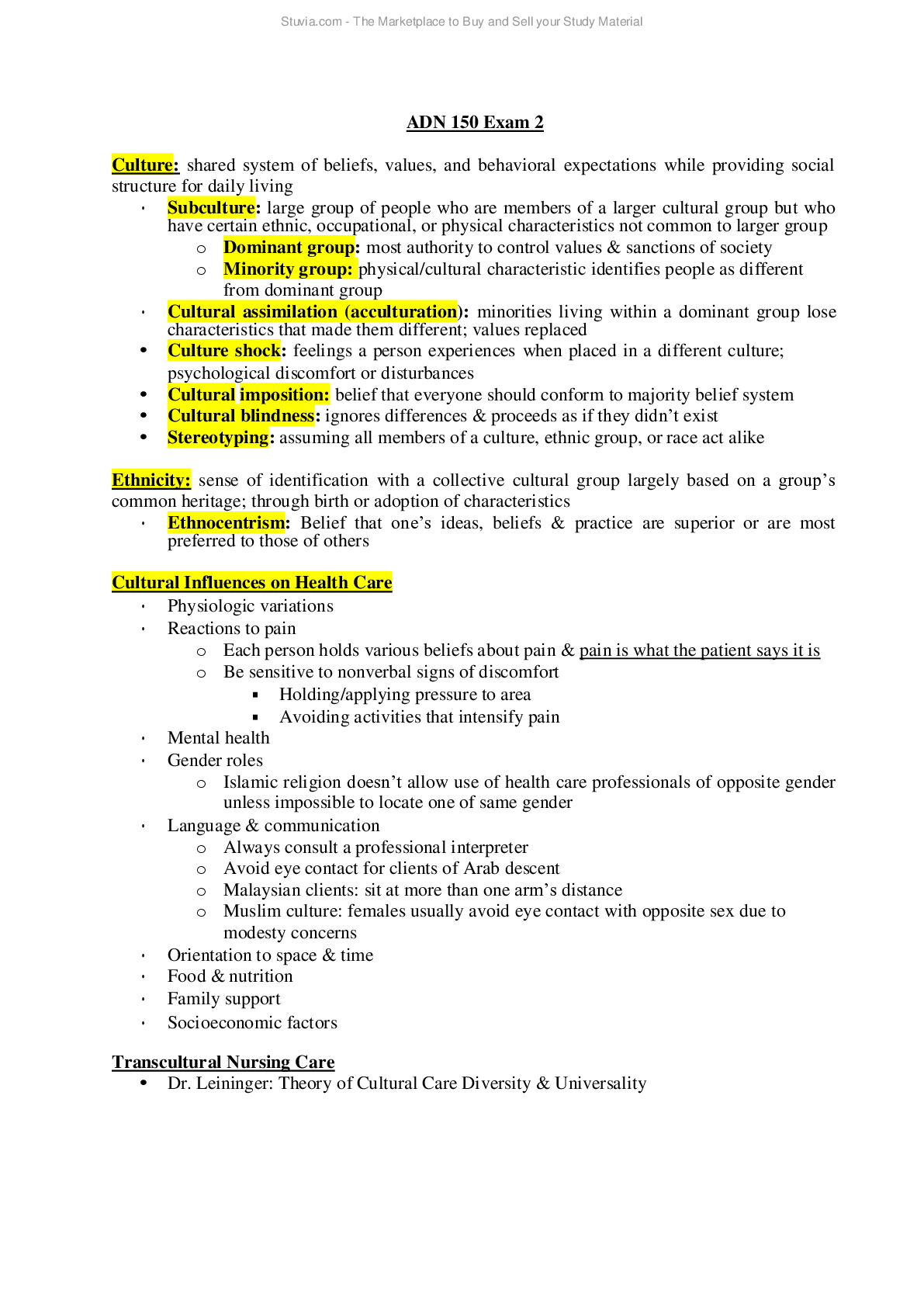
Reviews( 0 )
Document information
Connected school, study & course
About the document
Uploaded On
May 21, 2021
Number of pages
36
Written in
Additional information
This document has been written for:
Uploaded
May 21, 2021
Downloads
0
Views
78

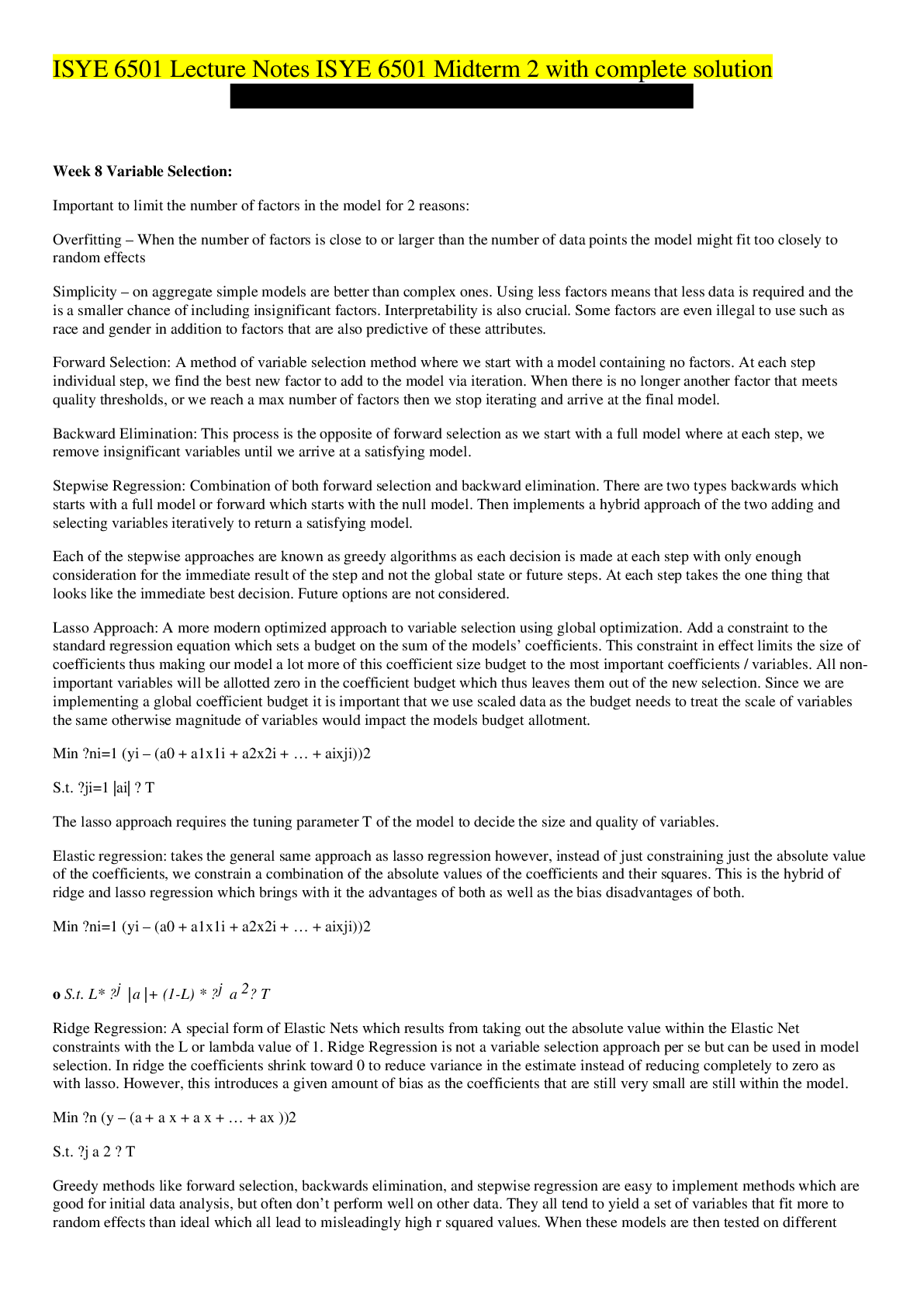
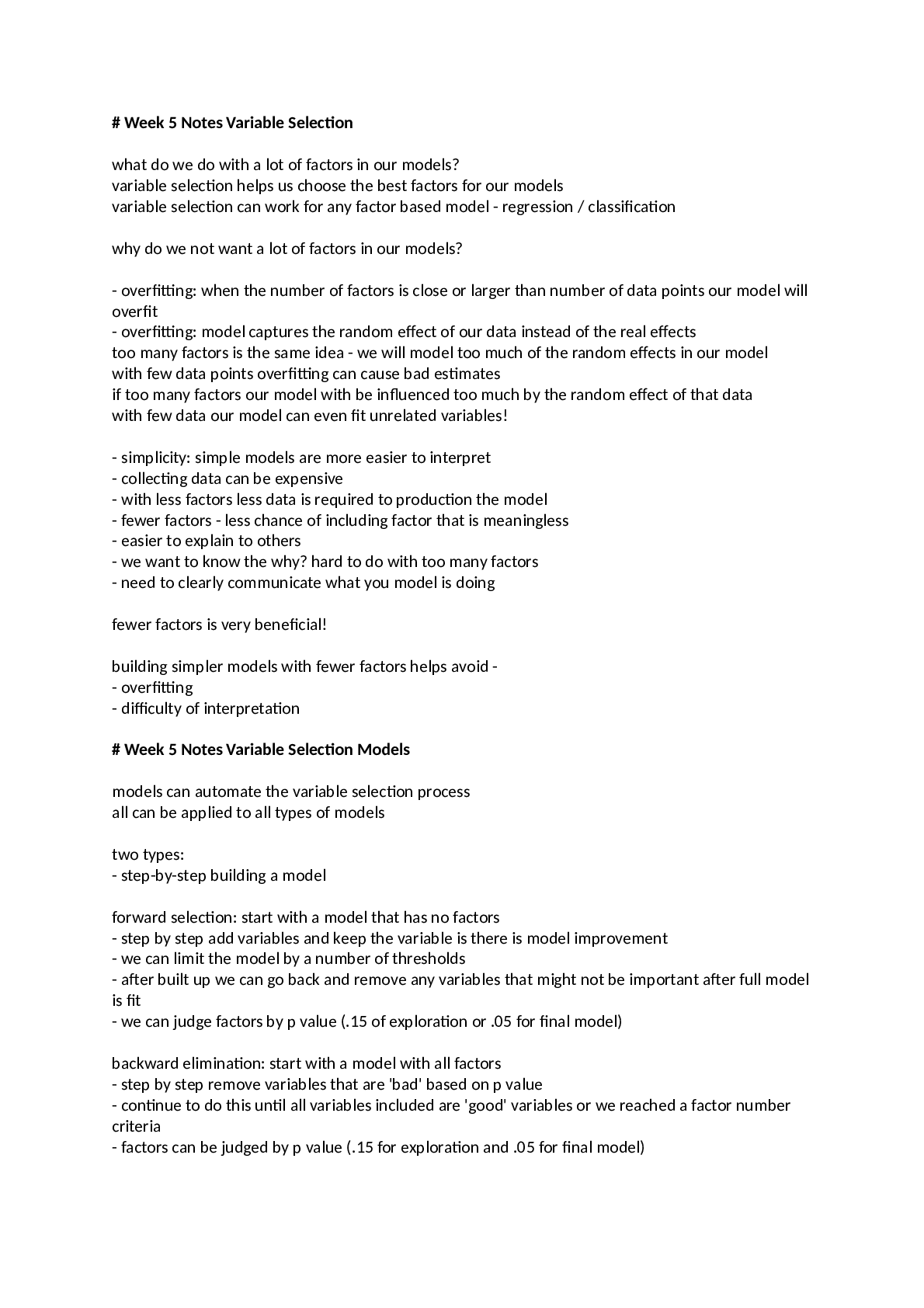
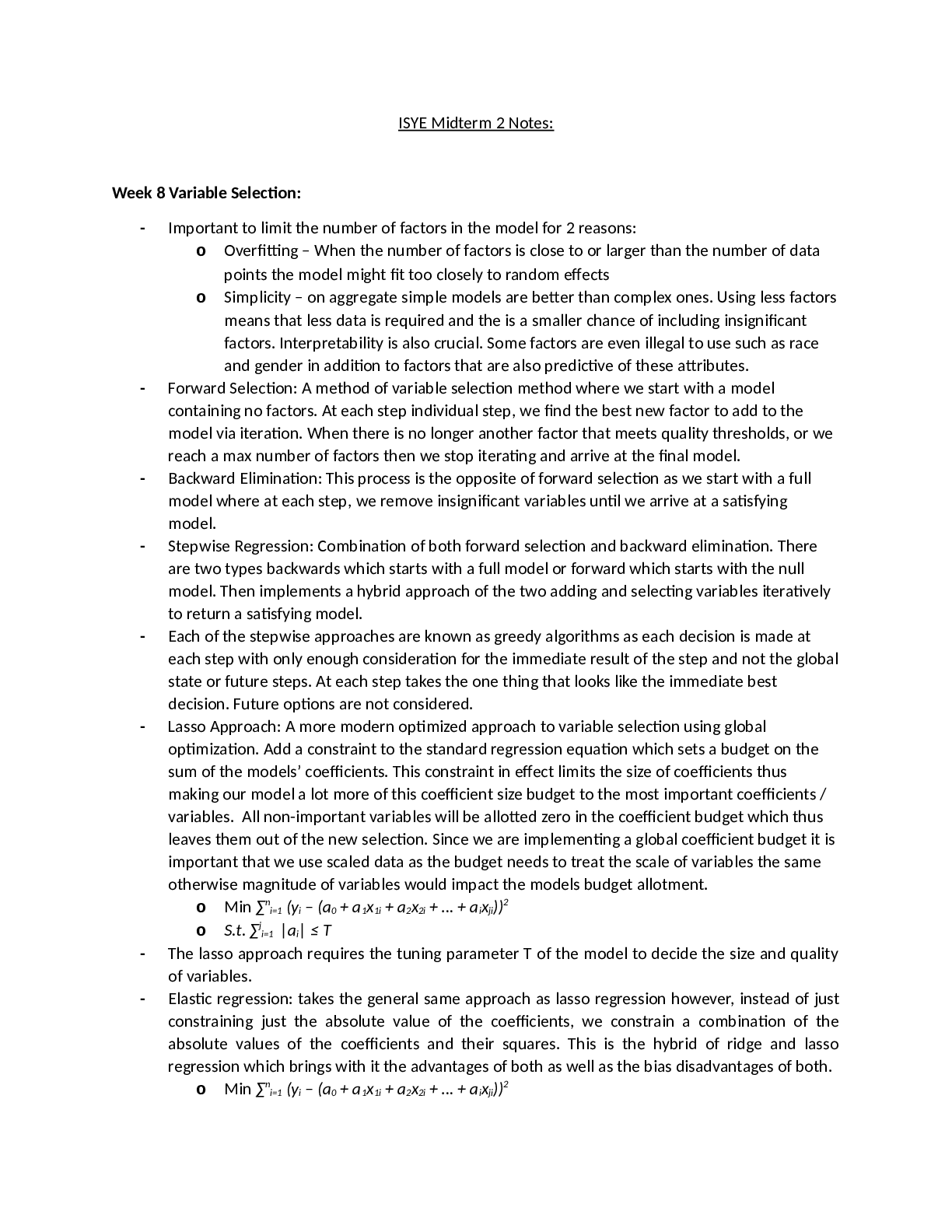
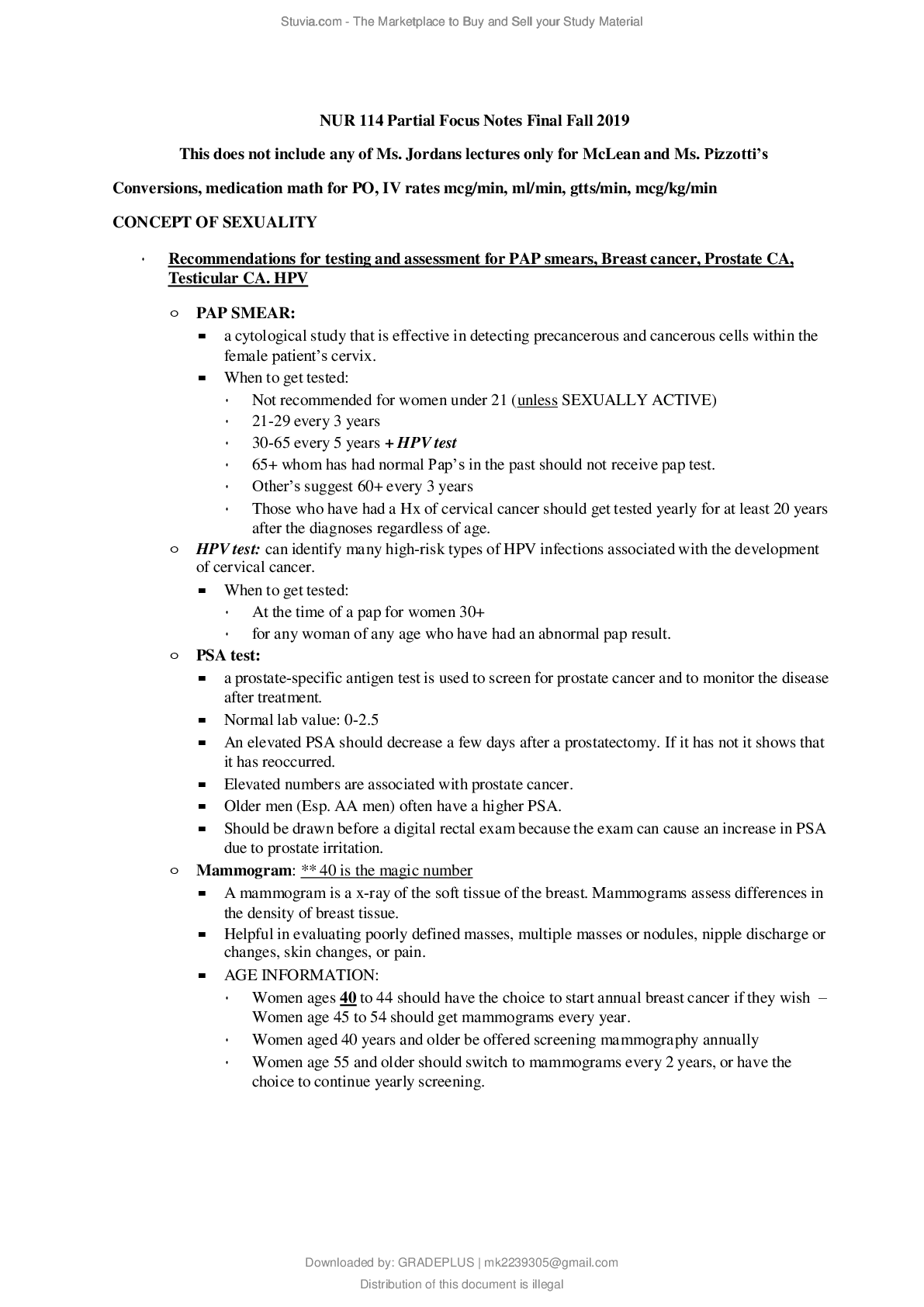
_removed.png)
